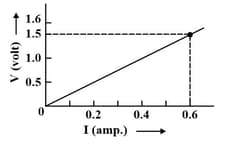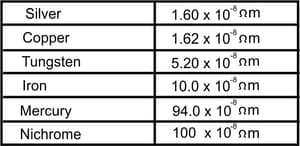What do the following symbols mean in circuit diagrams?
(i)

(ii)




Important Questions on Electricity
An electric circuit consisting of a 0.5 m long nichrome wire XY, an ammeter, a voltmeter, four cells of 1.5 V each and a plug key was set up.
(i) Draw a diagram of the electric circuit to study the relation between the potential difference maintained between the points ‘X’ and’ Y’ and the electric current flowing through XY.
(ii) Following graph was plotted between V and I values: What would be the values of V/I ratios when the potential difference is 0.8 V, 1.2 V and 1.6 V respectively? What conclusion do you draw from these values?

Electrical resistivity of some substances at are given below

| Silver | |
| Copper | |
| Tungsten | |
| Iron | |
| Mercury | |
| Nichrome |
Answer the following questions in relation to them:
(i) Among silver and copper, which one is a better conductor? Why? (ii) Which material would you advise to be used in electrical heating devices? Why?
